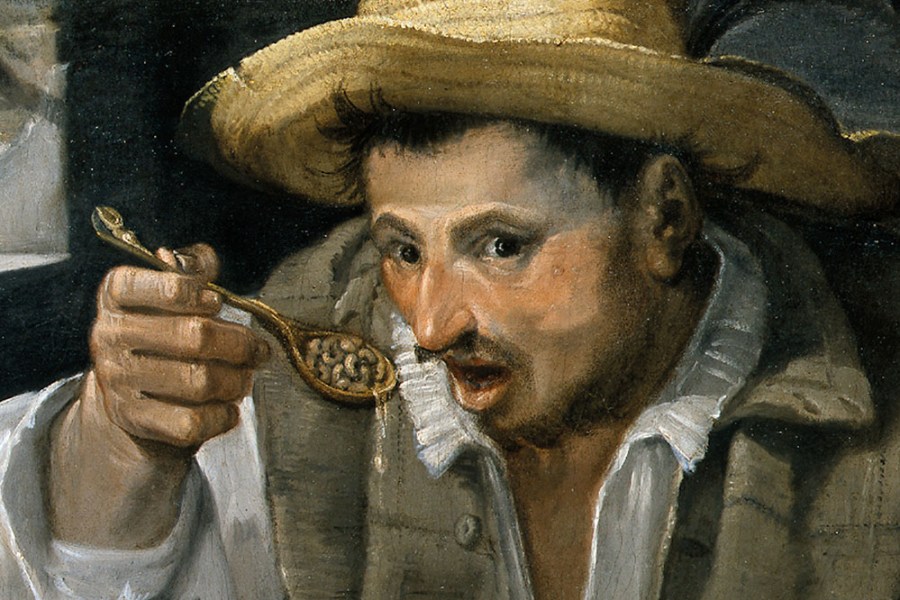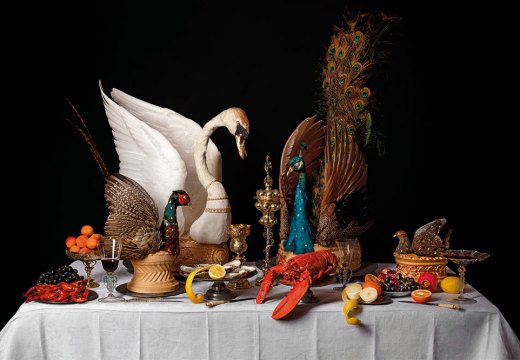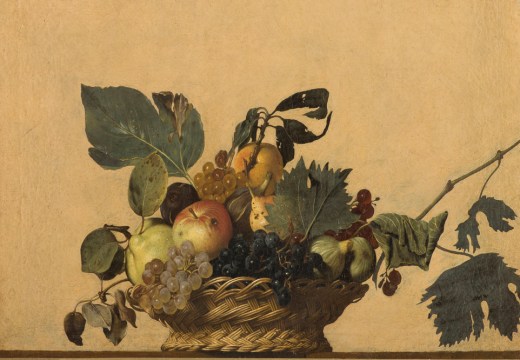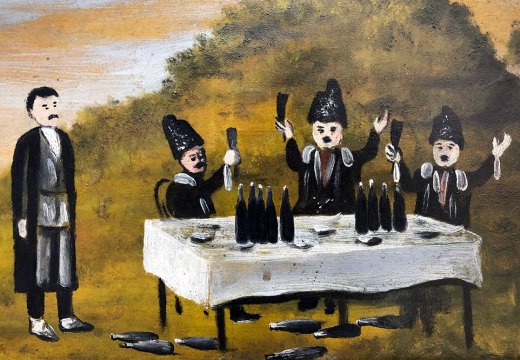From the April 2024 issue of Apollo. Preview and subscribe here.
A man eating alone looks up across his lunch at us, his eyebrows raised in mild surprise, if not annoyance. We’re not meant to be joining him (his table is set for one). If he is a hunter – there are feathers in his weather-beaten straw hat – he hasn’t had a successful morning of it: on the table is bread, wine, a knife, a bunch of spring onions or young leeks, a plate loaded with slices of a traditional Emilian chard or spinach pie called erbazzone and a bowl of braised white beans – but no meat or game. Or perhaps he’s sold a pheasant or two and plans to use the proceeds to pay his bill: as with many ‘realist’ pictures, what we don’t know about the scene is no less beguiling than what we do.
We are looking at a smallish early painting by the Bolognese artist and teacher Annibale Carracci, better known for his accomplished, allusive and somewhat operatic treatment of religious and mythological subjects. The Mangiafagioli or ‘bean-eater’ – the term is still used today, a little disparagingly, to refer to people from Tuscany, where such rustic dishes are common – is one of a handful of pictures Carracci produced in his twenties in a different key: peasants, urchins, a butcher’s shop, all executed Venetian-style, using a rough impasto laid on in quick strokes. They weren’t commissioned, it seems, but in due course they caught the eye of aristocratic collectors: not long after Carracci’s death his painting Butcher’s Shop (c. 1583) was in the Gonzaga collection, shortly to be sold to Charles I. The Mangiafagioli itself was spotted in the Pallavicini collection in Rome in 1679, and a century or so later in what would become the Galleria Colonna, whose website now pleasingly gives the picture’s English title as ‘The Bean Heater’.
These early pictures seem oddly out of kilter with the artist Carracci would become. They are specimens of what has been called realismo padano: scenes of ordinary contemporary life painted, generally in a subdued palette, by artists across northern Italy in the late 16th century. (The Mangiafagioli is looser and more painterly than the work of Carracci’s contemporary Caravaggio, but from across the room you might mistakenly attribute it to him.) In his first big religious commissions Carracci retained an interest in the humble humanity of his subjects: his biographer Malvasia says contemporaries criticised Saint Francis’s grimy feet in his Crucifixion (1583). But he soon changed course, steering towards the idealism of Raphael and Michelangelo – unlike Caravaggio, of course, whose religious paintings always had a gritty, Bicycle Thieves quality.

Il Mangiafagioli (c. 1580–90), Annibale Carracci. Galleria Colonna, Rome
It has been years since I visited the Galleria Colonna, but I remember the effect the Mangiafagioli had on me. I’m not even sure it’s a particularly good painting, but there’s something joltingly intimate about it. It is surprisingly rare to catch someone in the act of eating in art and, when you do, it’s likely to be someone poor – if not our bean-eater (there is also a Mangiapolenta, somewhat questionably attributed to Carracci) then a boozed-up Dutch peasant, perhaps; or one of Christ’s disciples at the Last Supper. There is a kind of morality at play here: we witness the subject in a moment of abandonment and vulnerability, and the subject – candidly, bravely and perhaps, as in the Mangiafagioli, a little grumpily – lets us do it. If you’re in a painting and you need to keep your status beyond question or your dignity intact, then your mouth had better stay closed. (A nymph or muse proffers a salver of sweetmeats to Apollo in Giulio Romano’s Wedding Feast of Cupid and Psyche of c. 1526–28, but he just wafts a godly hand over them.)
For a time, posterity was not kind to Carracci, or his kinsmen and fellow artists Ludovico (his cousin) and Agostino (his brother). They came to represent a nadir of derivative, formulaic and insincere art (in English 19th-century terms, they were ‘Raphaelites’.) Annibale’s realist phase might have been just another item on the charge sheet: how could such a versatile artist have a ‘true’ style of his own? But in the mid 20th century, scholars looked afresh at the early work and found new pathways connecting the different modes and phases of Carracci’s career. The later work is grounded in the observation not just of art, but also of life. The early work doesn’t merely hold a mirror up to the everyday world of the 1580s; it subtly enhances and intensifies it. The exertions of a butcher wrangling a beef carcass or a halberdier rummaging in his codpiece for money to pay him bear comparison to mighty Polyphemus, thrown off balance by the rock he’s preparing to hurl in Carracci’s Galleria Farnese frescoes. And while our bean-eater, spoon aloft in one hand, a fistful of bread clutched in the other, may not be what most people would think of as heroic, there’s something defiantly, enduringly human about him.
From the April 2024 issue of Apollo. Preview and subscribe here.
Unlimited access from just $16 every 3 months
Subscribe to get unlimited and exclusive access to the top art stories, interviews and exhibition reviews.














![Masterpiece [Re]discovery 2022. Photo: Ben Fisher Photography, courtesy of Masterpiece London](http://www.apollo-magazine.com/wp-content/uploads/2022/07/MPL2022_4263.jpg)
Has the Fitzwilliam lost the hang of things?